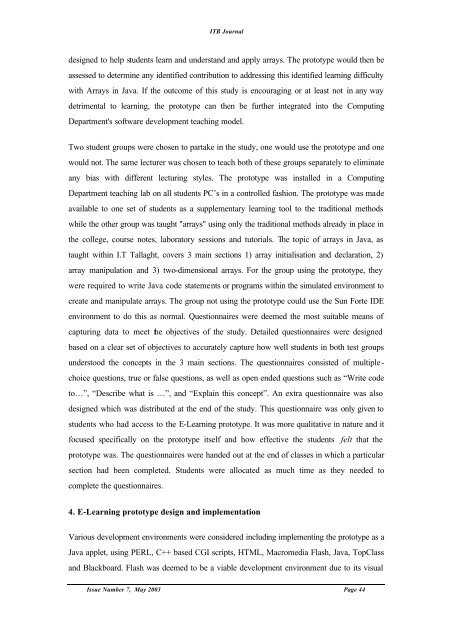ITB Journal-May-2003 - Institute of Technology Blanchardstown
ITB Journal-May-2003 - Institute of Technology Blanchardstown
ITB Journal-May-2003 - Institute of Technology Blanchardstown
Create successful ePaper yourself
Turn your PDF publications into a flip-book with our unique Google optimized e-Paper software.
<strong>ITB</strong> <strong>Journal</strong><br />
designed to help students learn and understand and apply arrays. The prototype would then be<br />
assessed to determine any identified contribution to addressing this identified learning difficulty<br />
with Arrays in Java. If the outcome <strong>of</strong> this study is encouraging or at least not in any way<br />
detrimental to learning, the prototype can then be further integrated into the Computing<br />
Department's s<strong>of</strong>tware development teaching model.<br />
Two student groups were chosen to partake in the study, one would use the prototype and one<br />
would not. The same lecturer was chosen to teach both <strong>of</strong> these groups separately to eliminate<br />
any bias with different lecturing styles. The prototype was installed in a Computing<br />
Department teaching lab on all students PC’s in a controlled fashion. The prototype was made<br />
available to one set <strong>of</strong> students as a supplementary learning tool to the traditional methods<br />
while the other group was taught "arrays" using only the traditional methods already in place in<br />
the college, course notes, laboratory sessions and tutorials. The topic <strong>of</strong> arrays in Java, as<br />
taught within I.T Tallaght, covers 3 main sections 1) array initialisation and declaration, 2)<br />
array manipulation and 3) two-dimensional arrays. For the group using the prototype, they<br />
were required to write Java code statements or programs within the simulated environment to<br />
create and manipulate arrays. The group not using the prototype could use the Sun Forte IDE<br />
environment to do this as normal. Questionnaires were deemed the most suitable means <strong>of</strong><br />
capturing data to meet the objectives <strong>of</strong> the study. Detailed questionnaires were designed<br />
based on a clear set <strong>of</strong> objectives to accurately capture how well students in both test groups<br />
understood the concepts in the 3 main sections. The questionnaires consisted <strong>of</strong> multiplechoice<br />
questions, true or false questions, as well as open ended questions such as “Write code<br />
to…”, “Describe what is …”, and “Explain this concept”. An extra questionnaire was also<br />
designed which was distributed at the end <strong>of</strong> the study. This questionnaire was only given to<br />
students who had access to the E-Learning prototype. It was more qualitative in nature and it<br />
focused specifically on the prototype itself and how effective the students felt that the<br />
prototype was. The questionnaires were handed out at the end <strong>of</strong> classes in which a particular<br />
section had been completed. Students were allocated as much time as they needed to<br />
complete the questionnaires.<br />
4. E-Learning prototype design and implementation<br />
Various development environments were considered including implementing the prototype as a<br />
Java applet, using PERL, C++ based CGI scripts, HTML, Macromedia Flash, Java, TopClass<br />
and Blackboard. Flash was deemed to be a viable development environment due to its visual<br />
Issue Number 7, <strong>May</strong> <strong>2003</strong> Page 44
















